Tags
Related Posts
Share This
Longmire in New Mexico
“Features are for sissies,” says Tom Walsh, production designer for the TV series “Longmire.” “I think that’s what the T-Shirt should say, because television requires a combination of stamina and humor. We joke that we’re actually short order chefs. We throw together scenery as quick as they throw it at us, and once we’re actually into the season, which we are now, we’re preparing and shooting and wrapping, simultaneously, all the time!”
 Walsh, who is successor to last season’s Production Designer David Blass, now adds his own artistic and professional flare to “Longmire,” whose team has returned to Garson Studios to shoot its third season (premiering in June). And while sets like the Sheriff station and Walt’s cabin are still in use from the first two seasons, Walsh’s team has integrated new sets, like a hospital room, and have started working with all new exterior and interior locations within the state of New Mexico.
Walsh, who is successor to last season’s Production Designer David Blass, now adds his own artistic and professional flare to “Longmire,” whose team has returned to Garson Studios to shoot its third season (premiering in June). And while sets like the Sheriff station and Walt’s cabin are still in use from the first two seasons, Walsh’s team has integrated new sets, like a hospital room, and have started working with all new exterior and interior locations within the state of New Mexico.
“The tradition of this show is a new designer every year,” says Walsh, who is familiar with northern New Mexico from his work in Vampires (1998), Beer for My Horses, and “In Plain Sight.” “It’s like a car, they change cars every year.” The hiring process, Walsh describes, is a result of the circumstances of production, a process that is never consistent or guaranteed. “It’s a hard show, doing only ten episodes a year. If you’re a freelancer, as we are, we have to fill in the rest of the year with other things and it doesn’t always work out that you’re available when they want to start up again.”
In the midst of moving the crew from Garson Studios to an exterior shoot in Las Vegas, Walsh says it’s all about being resourceful. “You can’t take anything for granted. It’s a lot of logistics, especially a show like this. You’re working out of trucks, you’re sending your crews to distant locations, so everything has to be thought out pretty well.”

Jessica Dias, assistant to Executive Producer Greer Shephard, sits on the set of Longmire’s Sheriff Station.
Jessica Dias, assistant to “Longmire’s” Executive Producer Greer Shephard, describes an ease in working with their Garson Studio “home space,” but admits that the challenge is then to find exterior locations in New Mexico that can be faked for Wyoming, where the story takes place.
“The location department has a really challenging job here,” Dias says. “Every time we want to use a house, school, or hotel, whatever, we can’t use adobe. They start to run out of locations and they can’t re-use places unless it’s reoccurring in the script.”
In creating the illusion of one fictional location, Dias says that the job of the 100 plus crew members is to make the transition of the exterior shots, places like the outside of the Sheriff’s office in Las Vegas, sync seamlessly with the interior sets on Garson stages. No one would know, for example, that between an exterior and interior shot of the station there is about an hour’s worth of driving, several truckloads of crew, and days worth of planning. “It’s all the different departments working together to make for an efficient smooth shooting process,” Dias says, “which is why you see us running around like crazy people, because it’s a lot to keep track of and a lot to get done.”
And while most hour-long dramas will dedicate five days to shooting on stage and two days to shooting on location, “Longmire’s” schedule is reversed. Most of their shots are exterior and involve interaction with the remote county of Wyoming, which is actually the remote counties of New Mexico. So while it does up the cost of the show, Dias explains, the atmosphere of the show is more authentic.
“That’s a lot of real estate that you go through and you have to find,” Walsh says. “Each [location] has to be unique and serve the purposes for that episode.” Walsh adds that working in remote places has allowed him to be “nimble and flexible.” While he has done work in Los Angeles studios with the ease of their resources, Walsh observes that people in those atmospheres get pretty lazy. “In LA you’ve got Warner Brothers and Universal pulling props and wardrobe for your shows. Here you have to go to Walmart and Hobby Lobby and Target. Somehow you have to make magic out of those. It is a fascinating business because we never do anything twice. You’re like a surfer…you’re on the tip, you’re on the back, sometimes you’re just hanging on to it.”






 Jackalope Magazine is the student magazine of Santa Fe University of Art and Design. Building on the interdisciplinary nature of our education, we aim to showcase the talent of our university and character of our city.
Jackalope Magazine is the student magazine of Santa Fe University of Art and Design. Building on the interdisciplinary nature of our education, we aim to showcase the talent of our university and character of our city.
I just wanted to say that you guys are doing a great job and your hard work is much appreciated! Keep up the good fight!
Kimber
It’s lovely to see another woman in my club! Keep up the “A” Jessica!